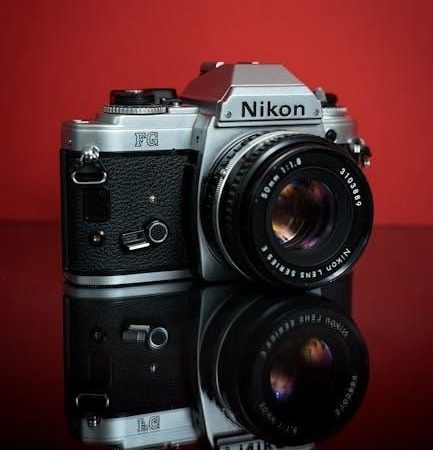Pandigital Digital Photo Frame⁚ A Comprehensive Guide
This guide provides comprehensive instructions for setting up, using, and troubleshooting your Pandigital digital photo frame. Learn about connecting power, memory cards, navigating menus, displaying photos, adjusting settings, and exploring advanced features. Discover troubleshooting tips and FAQs for optimal user experience.
Getting Started⁚ Initial Setup and Powering On
Unboxing your Pandigital digital photo frame reveals a sleek device ready to showcase your cherished memories. Before plugging it in, carefully inspect the package contents, ensuring you have the frame itself, the power adapter (usually a small wall wart), and potentially a remote control depending on your specific model. The power adapter should connect securely to the designated port on the back or side of the frame. Once connected, plug the adapter into a functioning electrical outlet. The frame should power on automatically, displaying a welcome screen or startup logo, indicating it’s successfully drawing power. If the screen remains blank, double-check the power connection, ensuring both the adapter and outlet are functioning correctly. Refer to the included quick-start guide or online manual for any model-specific instructions or troubleshooting steps. A brief period may be required for the device to initialize before displaying the main menu. The initial setup often involves selecting the preferred language and potentially connecting to a Wi-Fi network, depending on the model’s capabilities. This initial setup process establishes the foundational settings for your Pandigital photo frame experience, allowing you to begin importing and enjoying your photo collection. Remember to consult the user manual for detailed instructions specific to your model.
Connecting to Power and Memory Cards⁚ A Step-by-Step Guide
Powering your Pandigital digital photo frame is straightforward. Locate the power port, usually on the rear or side, and securely plug in the provided power adapter. Then, connect the adapter to a working electrical outlet. The frame should power on automatically. Next, insert your memory card. Most Pandigital frames accept SD cards, but check your model’s specifications for supported formats (SD, SDHC, SDXC, etc.). Carefully insert the card into the designated slot, ensuring it’s properly seated; a slight click often confirms successful insertion. The frame should automatically detect the memory card and begin indexing the images stored on it. If the frame doesn’t recognize the card, double-check the card’s orientation and ensure it’s not faulty. Sometimes, simply removing and reinserting the card can resolve detection issues. If problems persist, try a different, known-good memory card to rule out a card reader malfunction. For troubleshooting specific issues, consult the user manual. The manual will provide details about the frame’s power requirements and memory card compatibility. Remember to handle both the power adapter and memory card with care to prevent damage. Always safely eject the memory card before removing it from the frame to avoid data loss.
Navigating the Menu System⁚ Understanding the Interface
Your Pandigital digital photo frame’s menu system provides access to various settings and functions. The interface typically uses on-screen buttons or a directional pad on a remote control (if included). The main menu usually offers options for photo viewing, slideshow settings, clock display, and system configuration. Use the directional buttons to navigate through the menu options, highlighting your selection. Press the “OK” or “Select” button to confirm your choice and enter a submenu. Within each submenu, you can adjust settings, such as image rotation, slideshow speed, transition effects, and clock format (12-hour or 24-hour). Some models offer additional features like calendar integration, music playback, and even basic video support. Familiarize yourself with the on-screen icons and prompts. Most interfaces are intuitive and user-friendly, but referring to your Pandigital photo frame’s user manual will help clarify any uncertainties. The manual will provide detailed explanations of each menu option and its function. Mastering navigation is key to customizing your viewing experience and unlocking the full potential of your digital photo frame. Remember, the specific layout and features may vary slightly depending on your model, so consult your specific user manual for precise instructions.
Displaying Photos⁚ Importing and Viewing Images
To display your cherished memories, begin by inserting a compatible memory card (SD card, etc.) into the designated slot on your Pandigital digital photo frame. Ensure the card is correctly oriented; the frame will typically indicate the correct insertion method. The frame automatically detects the card and scans for image files. Supported formats commonly include JPEG, JPG, and sometimes others. Once detected, your photos will appear in a thumbnail view. Navigate using the frame’s controls (on-screen buttons or remote) to select an image for viewing. A full-screen display of the chosen photo will appear. Many Pandigital models offer slideshow functionality. Activate slideshow mode to automatically cycle through all the images on your memory card. Customize the slideshow’s settings, such as transition effects and display speed, through the menu system. You can pause, skip, or stop the slideshow at any time using the control buttons. If your Pandigital frame has network capabilities (some models do), it may allow for viewing photos from network storage or online cloud services. Consult your user manual for specific instructions on accessing these advanced features. Enjoy the convenience of sharing your digital memories with effortless display and slideshow options.
Image Settings⁚ Adjusting Brightness, Contrast, and More
Enhance your viewing experience by fine-tuning the image settings on your Pandigital digital photo frame. Access the settings menu, usually through an on-screen button or via the remote control (if applicable). Look for options to adjust brightness, contrast, and sharpness. Brightness controls the overall luminance of the displayed image; increase it for brighter images in dim lighting conditions and decrease it to reduce glare in bright environments. Contrast adjusts the difference between light and dark areas in the picture. Increase contrast for bolder, more vivid images, and decrease it for softer, less intense displays. Sharpness affects the clarity and definition of details. Increasing sharpness enhances fine details, while reducing it can soften the image and reduce artifacts. Some Pandigital models might offer additional image adjustments, such as color saturation, hue, or color temperature. Experiment with these settings to achieve your preferred visual style. Remember that optimal settings may vary depending on the image and the ambient lighting conditions. Take your time exploring the menu options to discover the best combination for your individual viewing preferences. Save your customized settings once you’re satisfied with the results. Enjoy personalized image enhancements that optimize your photo viewing pleasure.
Advanced Features⁚ Exploring Slideshow Options and Clock Settings
Unlock the advanced features of your Pandigital digital photo frame to personalize your viewing experience. Dive into the slideshow options to customize how your photos are displayed. Select from various transition effects, such as fades, wipes, or crossfades, to create a dynamic and engaging presentation. Adjust the slideshow speed to control how quickly images change, opting for a leisurely pace or a rapid-fire sequence depending on your preference. Many Pandigital frames allow you to set a timer for the slideshow, automatically turning it off after a specific duration. This is a handy feature for conserving energy and extending the life of your device. Beyond slideshows, explore the clock settings. Choose from different clock styles, formats (12-hour or 24-hour), and display options. You might be able to customize the clock’s color, size, and position on the screen. Some models even offer alarm functions, allowing you to set reminders or wake-up calls. By exploring the clock and slideshow settings, you can transform your Pandigital photo frame into a versatile and personalized home décor item.
Troubleshooting Common Issues⁚ Addressing Connectivity and Display Problems
Encountering difficulties with your Pandigital digital photo frame? This section guides you through resolving common connectivity and display issues. If your frame isn’t powering on, ensure the power cord is securely connected to both the frame and a functioning power outlet. Check the power outlet itself using another device. If the screen remains blank, verify that the memory card is correctly inserted and formatted compatibly with your frame. Refer to your user manual for supported formats. A blank screen could also indicate a faulty memory card; try a different one. If images aren’t displaying correctly, check the image file formats; ensure they’re compatible. Also, verify the orientation; some frames may have limitations. Poor image quality might be due to low resolution or corrupted files; If you experience connectivity problems when using a remote control, ensure fresh batteries are inserted and that there are no obstructions between the remote and the frame. Finally, a frozen screen often requires a power cycle—unplug the frame, wait a few seconds, and plug it back in. If problems persist after trying these steps, consult the manufacturer’s website for further assistance or contact customer support.
Memory Card Compatibility⁚ Supported Formats and File Types
Understanding your Pandigital digital photo frame’s memory card compatibility is crucial for seamless operation. This section details the supported formats and file types to ensure your images display correctly. Generally, Pandigital frames support common memory card types such as SD cards (Secure Digital), SDHC cards (Secure Digital High Capacity), and sometimes microSD cards (with an adapter). However, always refer to your specific frame’s user manual for confirmed compatibility, as models may vary. Regarding file formats, JPEG (Joint Photographic Experts Group) is the most widely supported format for images. This is due to its balance of image quality and file size efficiency. While some models might support other formats like PNG (Portable Network Graphics) or BMP (Bitmap), JPEG is the most reliable choice for universal compatibility. Before inserting a memory card, ensure it’s properly formatted. Incorrect formatting can lead to display errors or the inability to read the card. Your frame’s user manual should provide instructions on formatting. If you are unsure, carefully consult the online resources or contact customer support for assistance. Using incompatible cards or file types may result in error messages or a failure to display your photos correctly.
Using the Remote Control (if applicable)⁚ Optimizing Your User Experience
Many Pandigital digital photo frames include a convenient remote control to enhance user interaction and navigation. If your model includes a remote, familiarize yourself with its functionalities to optimize your experience. The remote typically allows for effortless control of various frame features without physically interacting with the device itself. Common remote functions include navigating through menus, selecting photos, initiating slideshows, adjusting settings like brightness and contrast, and controlling playback options. Before using the remote, ensure it has fresh batteries installed correctly. Low battery power can lead to erratic responses or complete failure. Point the remote directly at the infrared receiver on the photo frame for optimal signal transmission. The receiver’s location is usually indicated in the frame’s user manual. The remote’s buttons are typically intuitive and clearly labeled, simplifying navigation. However, consult your user manual for a detailed explanation of each button’s function and shortcuts. Mastering the remote control significantly enhances the convenience and usability of your Pandigital digital photo frame. Proper use ensures seamless navigation and effortless control over your image display.
Software Updates and Firmware⁚ Maintaining Optimal Performance
Regular software updates and firmware upgrades are crucial for maintaining optimal performance and functionality of your Pandigital digital photo frame. These updates often include bug fixes, enhanced features, and improved compatibility with various memory card formats and file types. To check for updates, navigate to the settings menu on your photo frame. The specific location of the update option varies depending on the model, but it’s usually found under a section labeled “System,” “Settings,” or “Support.” Follow the on-screen instructions to download and install any available updates. A stable internet connection is necessary for successful updates. During the update process, do not interrupt the power supply to the photo frame. Doing so could damage the device and render it unusable. After the update is complete, the frame will usually restart automatically. Refer to your user manual for detailed instructions on performing software updates and for troubleshooting steps if any issues arise during the update process. Keeping your Pandigital digital photo frame updated ensures optimal performance, enhanced features, and a smoother user experience.
Frequently Asked Questions (FAQs)⁚ Addressing Common User Queries
This section addresses common questions regarding your Pandigital digital photo frame. Q⁚ My photos aren’t displaying correctly. What should I do? A⁚ Ensure your memory card is properly inserted and formatted correctly. Check the image file types; some formats may not be supported. Adjust display settings like brightness and contrast. Q⁚ The frame is unresponsive. How do I fix it? A⁚ Try unplugging the frame from the power source for a few minutes, then plug it back in. If the problem persists, check for software updates. Q⁚ How do I change the slideshow settings? A⁚ Navigate to the “Settings” menu, then select “Slideshow.” Here, you can adjust the transition speed, effects, and the order in which your photos are displayed. Q⁚ What types of memory cards are compatible? A⁚ Refer to your user manual for a list of compatible memory card types and file formats. Q⁚ The screen is blank. What’s wrong? A⁚ Verify the power connection. Check the power outlet. Make sure the frame is turned on. Q⁚ Where can I find additional support? A⁚ Consult your user manual or visit the Pandigital website for troubleshooting tips and contact information.


